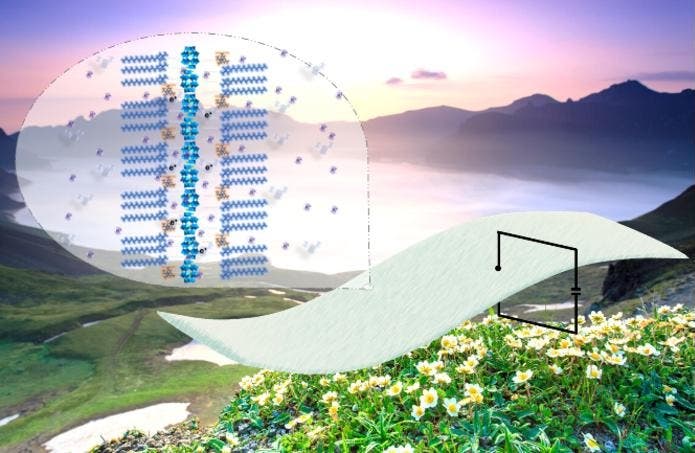Groundbreaking power generator runs on natural atmospheric humidity
Scientists are looking for ways to use the low-value energy widely distributed in natural environments to generate electricity.

[Aug 8, 2023: Yao Meng, Tsinghua University Press]
The polyoxometalate power generator collects the natural atmospheric humidity and produces continuous electrical signals by the uneven distribution and directional movement of ions, realizing efficient collection and utilization of low-value energy. (CREDIT: Nana Research, Tsinghua University Press)
Scientists are looking for ways to use the low-value energy widely distributed in natural environments to generate electricity. A research team has created a power generator that collects the natural atmospheric humidity and produces continuous electrical signals. This is the first humidity generator designed using a nano-sized material called polyoxometalates. It holds the potential of being a new research direction for polyoxometalates in the sustainable utilization of low-value energy.
The team’s work is published in the journal Nano Research.
The team set out to solve the problem of the discontinuity in the operation of energy conversion devices. They sought to address the shortage of atmospheric humidity power generation materials and the limited designable performance of materials.
“We wanted to understand the conversion process of atmospheric humidity energy to electrical energy and the role of polyoxometalates in the atmospheric humidity power generation,” said Weilin Chen, a professor in the Department of Chemistry at Northeast Normal University.
Related Stories
Polyoxometalates, known as POMs, have special morphology and functional properties, which make them very useful in controllable synthesis, assembly, and performance research. They are a versatile class of inorganic molecular materials. POM nanomaterials can self-assemble to form microporous structures that are capable of collecting atmospheric humidity.
They are also environmentally friendly, with great stability in light, heat, and chemical environments. Scientists expect that POM nanomaterials are the materials with the potential to effectively utilize atmospheric humidity.
The team constructed POMs into organic ammonium-polyoxoanion clusters. The clusters were assembled into thin films power generators with tiny, nano-sized pores called micropores, that are capable of working in atmospheric humidity. Their tiny POM generator produced a voltage of 0.68 V, was stable, and worked continuously under almost all-natural environments, with atmospheric humidity ranging from 10 percent to 90 percent.
A simple and multifunctional device with the polyoxometalate (POM)/ethyl cellulose composite film on metal substrate is prepared to individually/simultaneously generate electricity from multiple low-value all-weather environmental energy. (CREDIT: ScienceDirect)
The POM atmospheric humidity generator works as the POM nanoclusters spontaneously absorb atmospheric humidity with the micropores in POM nanowires films. They form a distribution gradient of water which is the structural basis of power generation. The POM generator has proven to have high stability and continuous power generation performance.
The team determined that the POM power generator can effectively collect the natural atmospheric humidity and produce continuous electrical signals by the uneven distribution and directional movement of ions. This work provides new ideas for the continuous use of low-value energy and a new research angle for polyoxometalate chemistry.
The P2W17 coated TiO2 nanoparticle film (P2W17-TNF) electrode was prepared using our reported electrochemical deposit method with some modifications. (CREDIT: ScienceDirect)
There has been an urgent need to develop a continuous low-value energy in a natural environment. In past research, scientists have created devices that collect and use low-value energy. But these devices have been limited because low-value energy is intermittent and unstable. In recent years, scientists have made progress in their use of atmospheric humidity energy. But the team’s POM generator is the first humidity generator to produce continuous power.
This POM generator has many potential applications, such as the detection of human respiratory processes; the detection, recording, and alarm of environmental humidity; the integration with electrical appliances to achieve continuous power supply of equipment; and meeting the electricity needs of multiple scenarios.
“The most important message is that continuous power generation using atmospheric humidity has been achieved through the design and modification of POMs nanomaterials, and the mechanism of atmospheric humidity power generation has been deeply understood by using the characteristics of POMs nanomaterials,” said Chen.
Looking ahead, the team hopes to improve the efficiency of atmospheric humidity power generation by screening and optimizing materials. They want to achieve a deeper understanding the atmospheric humidity power generation process.
“The ultimate goal is achieving the efficient use of humidity generators to promote sustainable development of energy and the environment by exploring the mechanism that optimizes the efficiency of the humidity generator,” said Chen.
The Chinese research team includes Tuo Ji and Weilin Chen from the Northeast Normal University; Zhenhui Kang from Soochow University; and Liming Zhang from the Chinese Academy of Sciences.
The research is funded by the National Natural Science Foundation of China, Science and Technology Research Project of the Education Department of Jilin Province, and the Natural Science Foundation of Jilin Province.
For more environmental news stories check out our Green Impact section at The Brighter Side of News.
Note: Materials provided above by the Tsinghua University Press. Content may be edited for style and length.
Like these kind of feel good stories? Get the Brighter Side of News' newsletter.
Joseph Shavit
Head Science News Writer | Communicating Innovation & Discovery
Based in Los Angeles, Joseph Shavit is an accomplished science journalist, head science news writer and co-founder at The Brighter Side of News, where he translates cutting-edge discoveries into compelling stories for a broad audience. With a strong background spanning science, business, product management, media leadership, and entrepreneurship, Joseph brings a unique perspective to science communication. His expertise allows him to uncover the intersection of technological advancements and market potential, shedding light on how groundbreaking research evolves into transformative products and industries.



